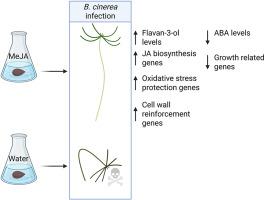Methyl jasmonate seed treatment enhances Norway spruce seedling resistance to Botrytis cinerea via a multitude of defense responses
IF 5.7
2区 生物学
Q1 PLANT SCIENCES
引用次数: 0
Abstract
Methyl jasmonate (MeJA) is known to effectively protect Norway spruce (Picea abies) against pests and pathogens. However, MeJA application to spruce saplings can significantly reduce growth and is not feasible to use in protecting older trees due to cost. Seed treatment with MeJA or other priming stimulants with fewer negatives could be a practical solution to enhance Norway spruce resistance. Therefore, we assessed the potential of Norway spruce seed treatment with MeJA, pipecolic acid (PipA), lignan (Li), and chitosan (Chi) in enhancing the resistance of the emerged seedlings against Botrytis cinerea. For the first time, MeJA seed treatment was shown to reduce the mortality of the seedlings effectively after B. cinerea infection, with a growth reduction as a side effect. To understand the mechanisms underlying this phenomenon, we quantified phenolics, defense hormones, and differential transcript expressions. MeJA seed treatment increased the concentration of the flavan-3-ols catechin and proanthocyanidin B1. Transcriptomic data suggested an increase in oxidative stress protection, cell wall reinforcement, and pathogenesis-related protein production. Our data also suggested an antagonistic relationship in hormonal signaling between abscisic acid (ABA) and jasmonic acid (JA)/ethylene (ET). Overall, our findings indicated MeJA seed treatment enhanced resistance of young seedlings against B. cinerea via a multitude of defense responses, modulated by complex regulatory systems.

茉莉酸甲酯种子处理通过多种防御反应增强挪威云杉幼苗对灰霉病的抗性
众所周知,茉莉酸甲酯(MeJA)可以有效地保护挪威云杉(Picea abies)免受害虫和病原体的侵害。然而,MeJA应用于云杉树苗会显著减少生长,并且由于成本原因,不适合用于保护老树。用MeJA或其他负极较少的启动兴奋剂处理种子可能是增强挪威云杉抗性的实际解决方案。因此,我们评估了MeJA、胡椒果酸(PipA)、木脂素(Li)和壳聚糖(Chi)处理挪威云杉种子对葡萄灰霉病抗性增强的潜力。MeJA种子处理首次被证明可以有效降低灰葡萄球菌感染后幼苗的死亡率,但其副作用是生长减慢。为了了解这种现象背后的机制,我们量化了酚类物质、防御激素和差异转录表达。MeJA种子处理增加了黄烷-3-醇儿茶素和原花青素B1的浓度。转录组学数据表明,氧化应激保护、细胞壁强化和发病相关蛋白的产生增加。我们的数据还表明,脱落酸(ABA)和茉莉酸(JA)/乙烯(ET)在激素信号传导中存在拮抗关系。总的来说,我们的研究结果表明,MeJA种子处理通过多种防御反应增强了幼苗对灰葡萄球菌的抗性,这些反应是由复杂的调控系统调节的。
本文章由计算机程序翻译,如有差异,请以英文原文为准。
求助全文
约1分钟内获得全文
求助全文
来源期刊
CiteScore
11.10
自引率
3.10%
发文量
410
审稿时长
33 days
期刊介绍:
Plant Physiology and Biochemistry publishes original theoretical, experimental and technical contributions in the various fields of plant physiology (biochemistry, physiology, structure, genetics, plant-microbe interactions, etc.) at diverse levels of integration (molecular, subcellular, cellular, organ, whole plant, environmental). Opinions expressed in the journal are the sole responsibility of the authors and publication does not imply the editors'' agreement.
Manuscripts describing molecular-genetic and/or gene expression data that are not integrated with biochemical analysis and/or actual measurements of plant physiological processes are not suitable for PPB. Also "Omics" studies (transcriptomics, proteomics, metabolomics, etc.) reporting descriptive analysis without an element of functional validation assays, will not be considered. Similarly, applied agronomic or phytochemical studies that generate no new, fundamental insights in plant physiological and/or biochemical processes are not suitable for publication in PPB.
Plant Physiology and Biochemistry publishes several types of articles: Reviews, Papers and Short Papers. Articles for Reviews are either invited by the editor or proposed by the authors for the editor''s prior agreement. Reviews should not exceed 40 typewritten pages and Short Papers no more than approximately 8 typewritten pages. The fundamental character of Plant Physiology and Biochemistry remains that of a journal for original results.

 求助内容:
求助内容: 应助结果提醒方式:
应助结果提醒方式:


